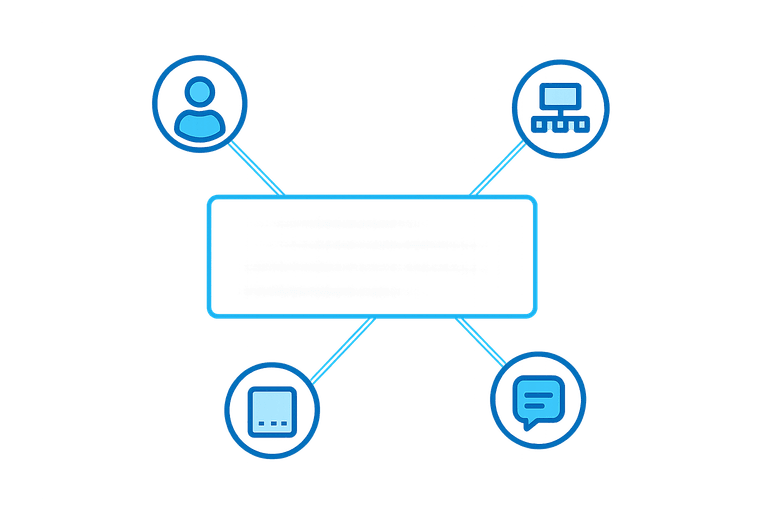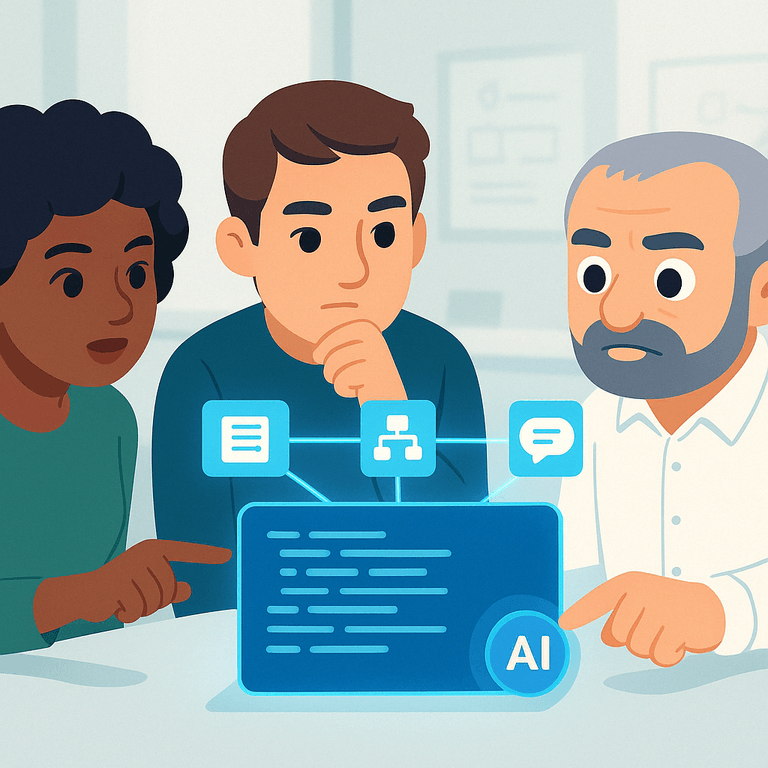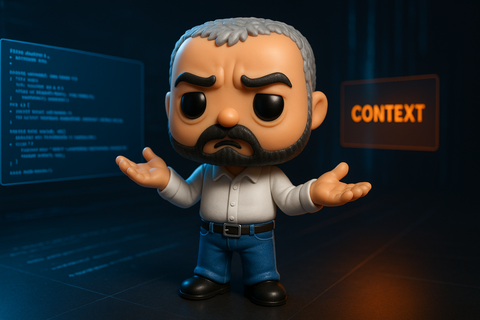The dangerous illusion of AI productivity (and how to achieve real gains)
Beyond vanity metrics: Achieving sustainable AI productivity gains with the PAELLADOC framework

Remember that feeling? The promise of AI coding assistants. Write code faster. Ship features quicker. Leave the competition in the dust. It felt like finding a magic button for developer productivity.
But then came the hangover. Six months down the line, trying to understand that AI-generated marvel feels like deciphering ancient hieroglyphs. What should be a simple tweak becomes a week-long excavation through layers of context-free code. Days bleed into nights. Frustration mounts.
That’s the dangerous illusion. You chased speed, but you lost something far more valuable: sustainable productivity. Ignoring this hidden cost doesn’t just slow you down; it grinds your projects to a halt, making your AI investments a liability, not an asset. Let’s dissect this illusion and discover how to harness AI for real, lasting gains.
The productivity mirage: Why AI coding tools create false impressions
Picture this: Team Alpha, sharp engineers hungry for an edge. They adopt the latest AI coding tools – Copilot, CodeWhisperer, you name it. The initial results are spectacular. Boilerplate code vanishes in seconds. Unit tests appear almost magically. Lines of code metrics soar through the roof. Management is ecstatic. Features fly out the door at warp speed. They feel unstoppable.
Fast forward three months. A critical bug surfaces in production, impacting key customers. Panic stations. The module responsible was largely generated by an AI assistant, prompted by a developer who has since moved to another project. The remaining team dives in.
They stare at the elegant, functional, yet utterly alien code. It works, mostly. But why does it work this way? What edge cases were considered? What architectural constraints were assumed? There are no comments explaining the intent, no links to the original requirements (unlike the principles discussed in Documentation in the Age of AI), no record of the prompts used. Just… code. Perfectly formed, context-stripped logic.
What was supposed to be a quick hotfix turns into a painful forensic investigation. Debugging becomes a nightmare – stepping through unfamiliar logic, trying to guess the AI’s implicit assumptions. Integrating a small change requires understanding the entire black box, fearing unforeseen side effects, a problem hinting that perhaps Your AI Projects Are Unsustainable. Days turn into weeks. The velocity achieved earlier? A distant memory, evaporated by the friction of maintaining contextless code. The team burns out, morale plummets. They generated code faster than ever, yes. But they sacrificed understandability and long-term maintainability on the altar of short-term speed.
Hard data: The hidden costs of contextless AI code
The promise of AI-driven speed is intoxicating. Studies confirm impressive gains: developers using tools like GitHub Copilot or Amazon CodeWhisperer can complete certain coding tasks up to 55-57% faster (Source: Medium (Adnan Masood, PhD.), Mar 2025). Some organizations report productivity improvements averaging 7-18% across the SDLC, with specific task speed-ups potentially reaching 40% or more (Source: Capgemini, Feb 2025, citing MIT study).
But here’s the hidden cost: This raw speed often comes at the expense of long-term code health and maintainability. A large-scale study by GitClear analyzing code through 2024 found worrying trends since the widespread adoption of AI tools (Source: GitClear, 2025 Report Summary).
- Skyrocketing code churn & duplication: GitClear projects code churn (code discarded shortly after writing) to double compared to pre-AI baselines. They also observed a 4x increase in cloned code blocks in 2024, with copy/pasted code exceeding refactored/moved code for the first time – a strong indicator of declining code reuse and growing redundancy (Sources: DevOps.com citing GitClear, Feb 2025; GitClear 2025 Report).
- Increased debugging & instability: The State of Software Delivery 2025 report found developers spending more time debugging AI-generated code and resolving security issues. Similarly, Google’s 2024 DORA report linked a 25% increase in AI usage to a 7.2% decrease in delivery stability (Source: LeadDev, Feb 2025).
- AI-induced technical debt: The ease of generation without deep context acts as a technical debt accelerator. An MIT professor likened it to a “brand new credit card…to accumulate technical debt in ways we were never able to do before” (Source: DevOps.com, Feb 2025). Experts predict this could lead to “system gridlock” as teams untangle messy, AI-generated functions (Source: DevOps Digest, Dec 2024).
Concerns about AI code quality and security vulnerabilities persist in 2025 (Source: Zencoder.ai, Mar 2025), and developers, especially juniors, worry about reduced learning opportunities due to reliance on AI under tight deadlines (Source: Dev.to, Apr 2025). Focusing solely on initial generation speed ignores the ballooning cost of understanding, debugging, and maintaining this rapidly generated, often context-poor code.
Understanding the core issue: Speed vs. sustainable productivity
So, what went wrong? We fell for the siren song of speed, confusing rapid code generation with true, sustainable engineering productivity. It’s like mistaking a sprinter’s burst for a marathon runner’s endurance. The real bottleneck in software development isn’t how fast developers can type; it’s the cognitive load involved in understanding, maintaining, and safely evolving complex systems over time.
AI coding assistants are phenomenal pattern matchers, generating code based on billions of lines they’ve seen. But they operate largely without deep, project-specific context. They don’t inherently grasp:
- The why: The business logic, user needs, or strategic goals driving a particular feature.
- The architecture: Your system’s specific design principles, constraints, trade-offs, and established patterns.
- The history: Why previous approaches were abandoned, existing technical debt, or past bugs that inform current choices.
- The dependencies: Subtle interactions, potential side effects, or downstream impacts on other modules.
Without this rich context, the AI generates code in a vacuum. It might be locally correct, even elegant, but it’s often filled with implicit assumptions and hidden dependencies. It becomes a black box, increasing the cognitive load for anyone who needs to understand or modify it later because they must reconstruct the missing context from scratch.
True productivity isn’t just writing code faster today. It’s minimizing the total cost and effort over the software’s entire lifecycle. It’s measured by how quickly and safely your team can understand, modify, test, and extend that code tomorrow, next month, next year. It encompasses:
- Maintainability: Low effort required to fix bugs or adapt to changing requirements.
- Understandability: High clarity of code purpose and logic for current and future developers.
- Collaboration velocity: Reduced friction when multiple developers work concurrently.
- Reduced cognitive load: Less mental energy spent deciphering, more spent creating value.
Focusing only on generation speed optimizes for the easy part, while dangerously accumulating debt where it hurts most: in the long-term understandability and adaptability of your system.
Building sustainable AI productivity: A context-centric blueprint
Stop chasing the illusion. Achieve real AI-powered productivity by integrating AI tools intelligently into a workflow that prioritizes context, clarity, and long-term health.
Here’s the blueprint:
1. Measure what matters: Ditch the vanity metrics
- Stop measuring LOC: Lines of code generated by AI? Irrelevant. It incentivizes volume over value.
- Focus on flow & stability: Embrace DORA metrics (Lead Time, Deployment Frequency, Change Fail Rate, Time to Restore) and SPACE framework insights. These reflect system health.
- Track the friction: Monitor Code Churn, Rework Rate, Bug Resolution Time (compare AI-generated vs human), and Code Review Cycle Time. High numbers here cancel out initial speed gains. We’ll explore Measuring Real Productivity in AI Development in a future article.
- Gauge understandability: How fast can new devs contribute? Qualitative feedback reveals more than code counters.
- Benefit: Aligns incentives with value. Focuses on delivering stable, working software efficiently over the long haul.
2. Embed the why with the what: Prioritize context preservation
- Before: Documentation rotting in a separate wiki, ignored and untrusted.
- Now: Living context with Paelladoc. Create explicit, durable links between code and its reason for being – requirements, ADRs, design discussions, performance goals. Use tools like Paelladoc to build this living knowledge graph within your development environment.

- Mandate context capture: When AI generates significant code, capturing the why (the prompt, the decision, the requirement link) using Paelladoc isn’t optional, it’s essential.
- Benefit: Transforms debugging. Understand purpose in minutes, not hours.
- Benefit: Enables safer evolution. Refactor with confidence, knowing the original constraints.
- Benefit: Supercharges onboarding. New hires access project wisdom instantly.
- Benefit: Democratizes knowledge. Context becomes a shared, persistent asset.
3. Guide the assistant: Demand context-aware AI interaction
- Rich prompting is key: Don’t just ask what, explain why and how. Provide architectural context, interface definitions, style guides, and requirement links.
- Iterate and validate: Treat AI output as a draft. Refine it with follow-up prompts focusing on project specifics, edge cases, and adherence to standards.
- Feed it your best: Show the AI examples of your high-quality, context-rich code to steer its output.
- Benefit: Get AI suggestions tailored to your project, not generic internet code.
4. Reinforce the human firewall: Context-driven code reviews
- AI code isn’t magic: It needs more scrutiny, not less, specifically focusing on hidden assumptions and context gaps.
- Augment your checklist: Ask: Is the intent clear? Is context captured (e.g., via Paelladoc)? Are dependencies handled correctly? Does it truly fit the architecture? Could someone else maintain this safely later?
- Use context tools in review: Leverage tools that surface linked rationale during review.
- Benefit: Catches AI-induced debt and ambiguity before it infects your codebase.
5. Build a culture of sustainable AI
- Train for critical use: Focus training on when and why to use AI, emphasizing validation and context capture.
- Value guidance over generation: Reward effective prompting and validation, not just LOC output.
- Share learnings: Create channels to share best practices and pitfalls.

- Benefit: Cultivates collective intelligence for responsible and effective AI augmentation.
Embracing these practices transforms AI from a potential source of technical debt into a powerful amplifier for human developers, driving sustainable velocity and higher quality.
Introducing PAELLADOC: A framework for genuine AI productivity
P: Prompt engineering built on shared context
A: Agent assistance with runtime context
E: Enhanced retrieval augmentation
L: LLM evaluation automation
L: Large-scale telemetry collection
A: AI tooling governance
D: Documentation amplification
O: Operational monitoring
C: Continuous feedback mechanisms
From illusion to reality: Measuring actual AI productivity
Conclusion: Choose sustainable productivity
Chasing AI speed without managing context is a dangerous illusion. You win the sprint but lose the marathon, drowning in unmaintainable code.
The real power lies in augmenting human developers, leveraging AI to enhance their understanding and capabilities, not replace them. True productivity delivers systems built not just fast, but well – clear, understandable, maintainable, and easy to evolve safely.
Stop the illusion. Start building sustainably. Preserve the context. Make your AI-generated code an asset, not a ticking time bomb.
Ready to inject context back into your AI development workflow? Discover how Paelladoc helps teams build faster and smarter. Will you keep accumulating hidden technical debt, or will you build a foundation for lasting productivity? The choice is yours.


